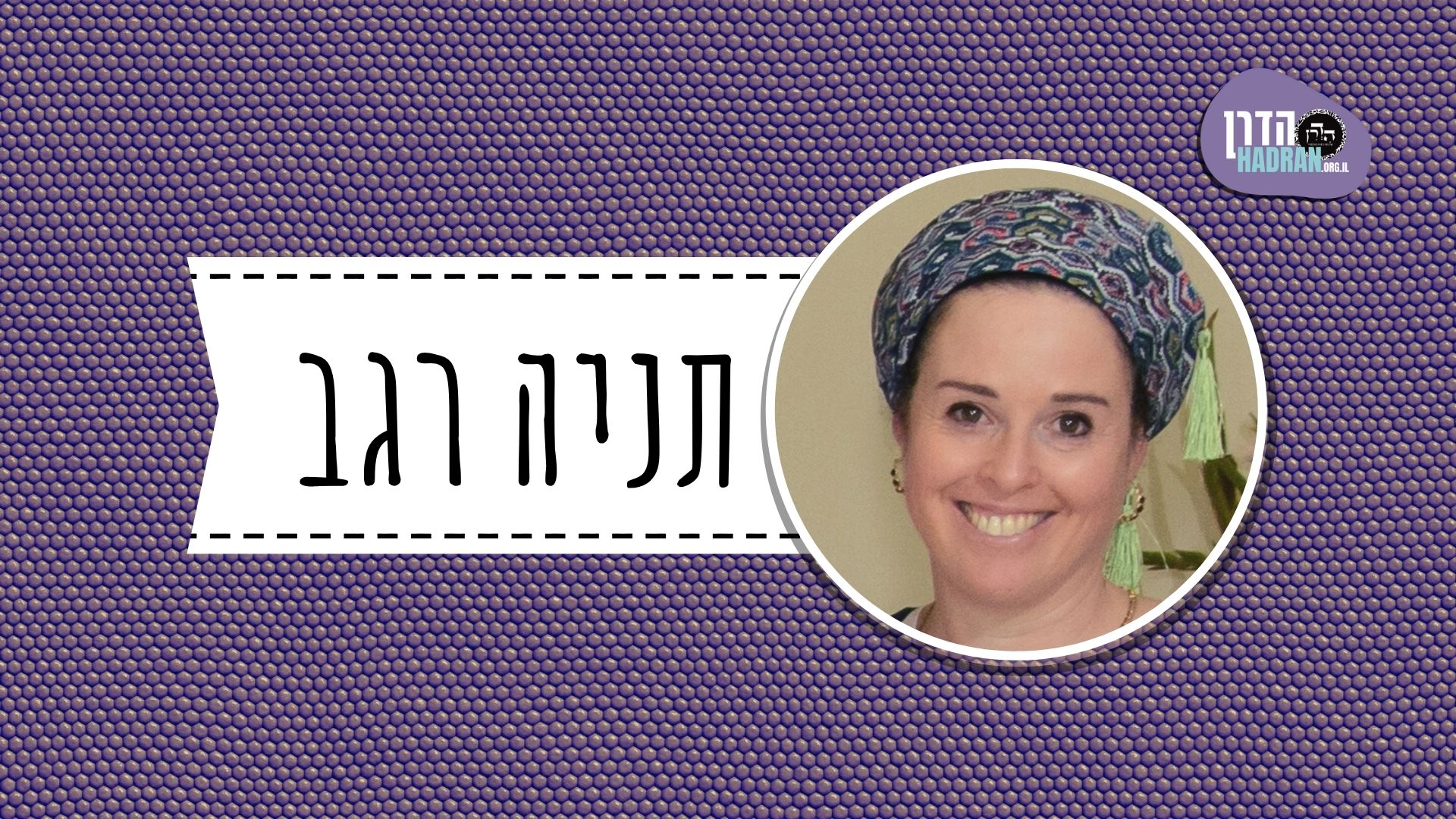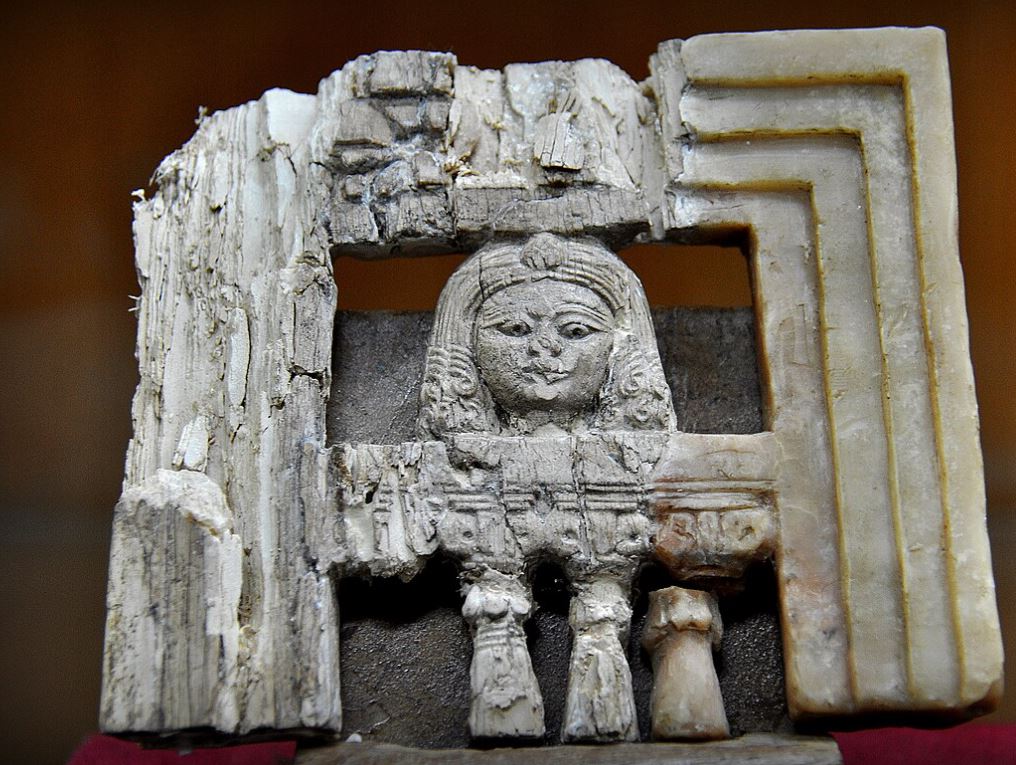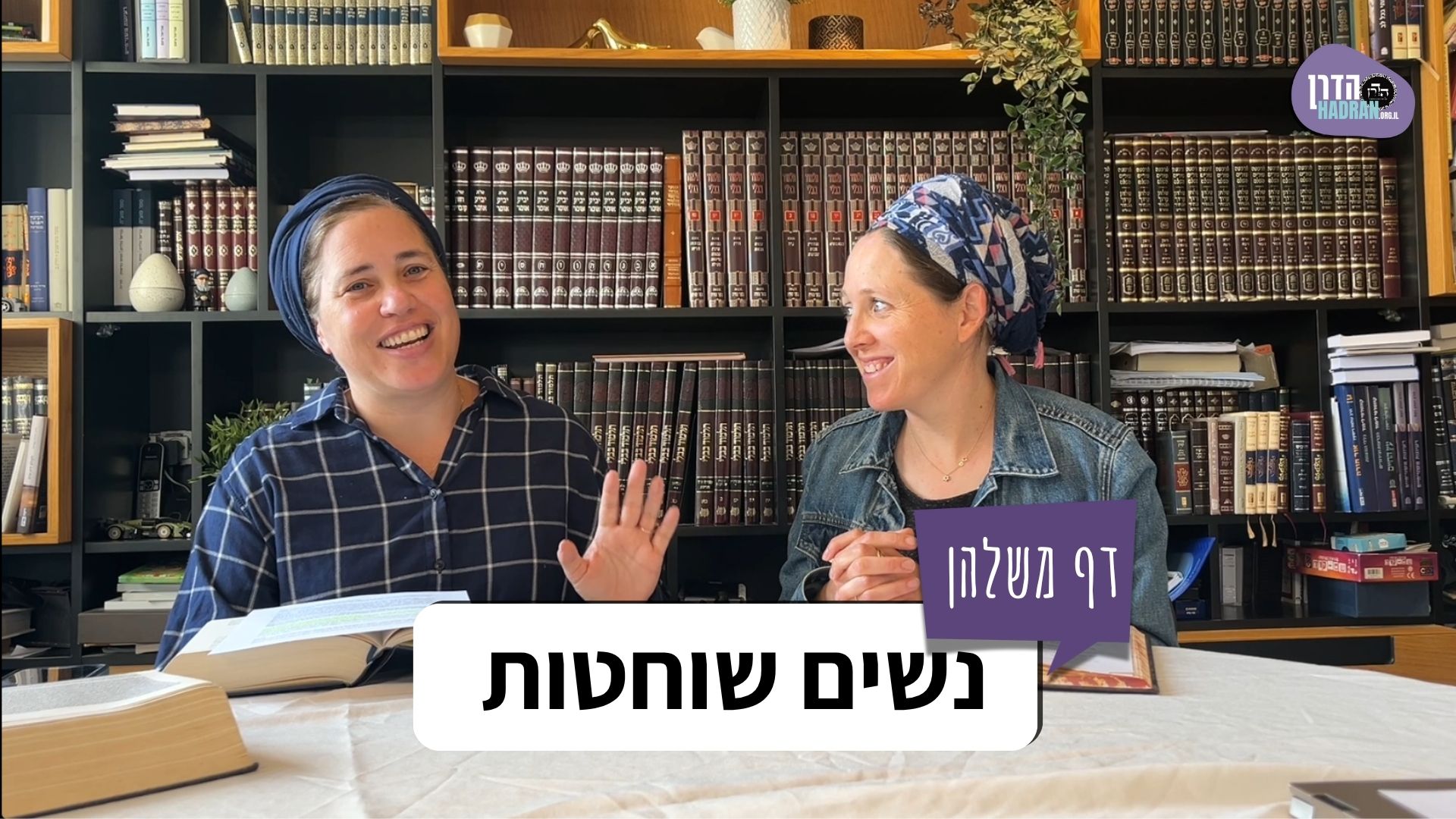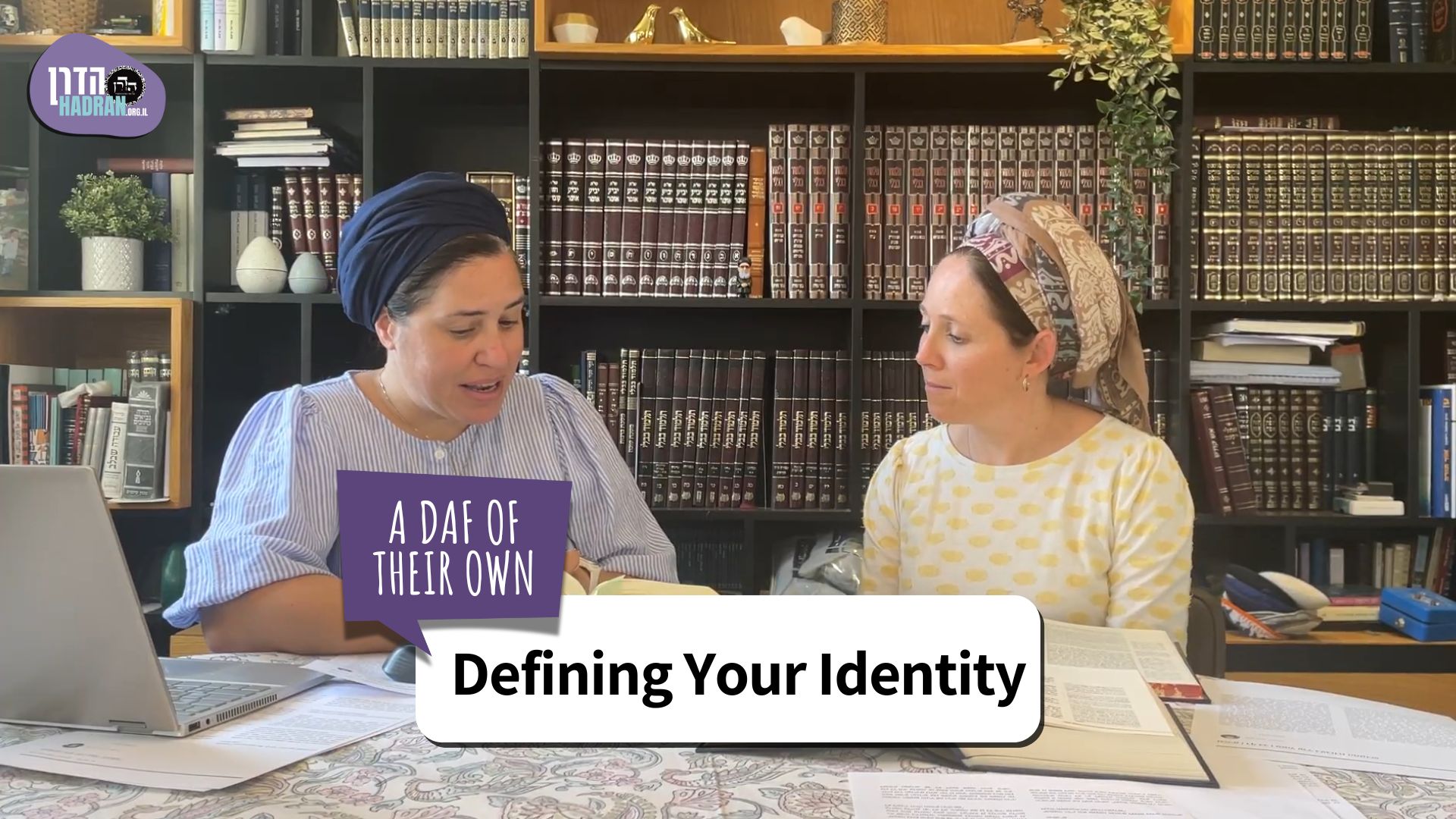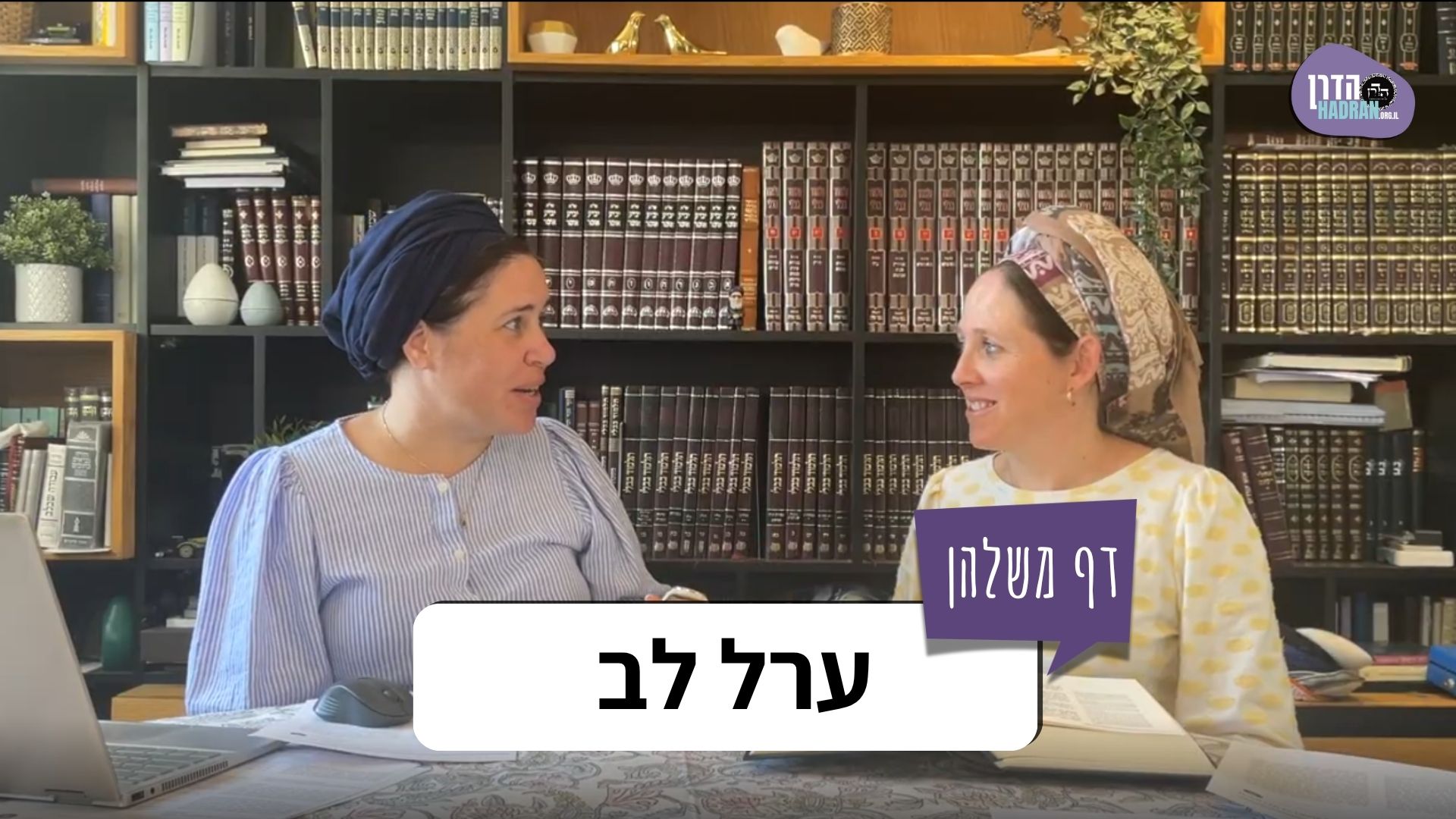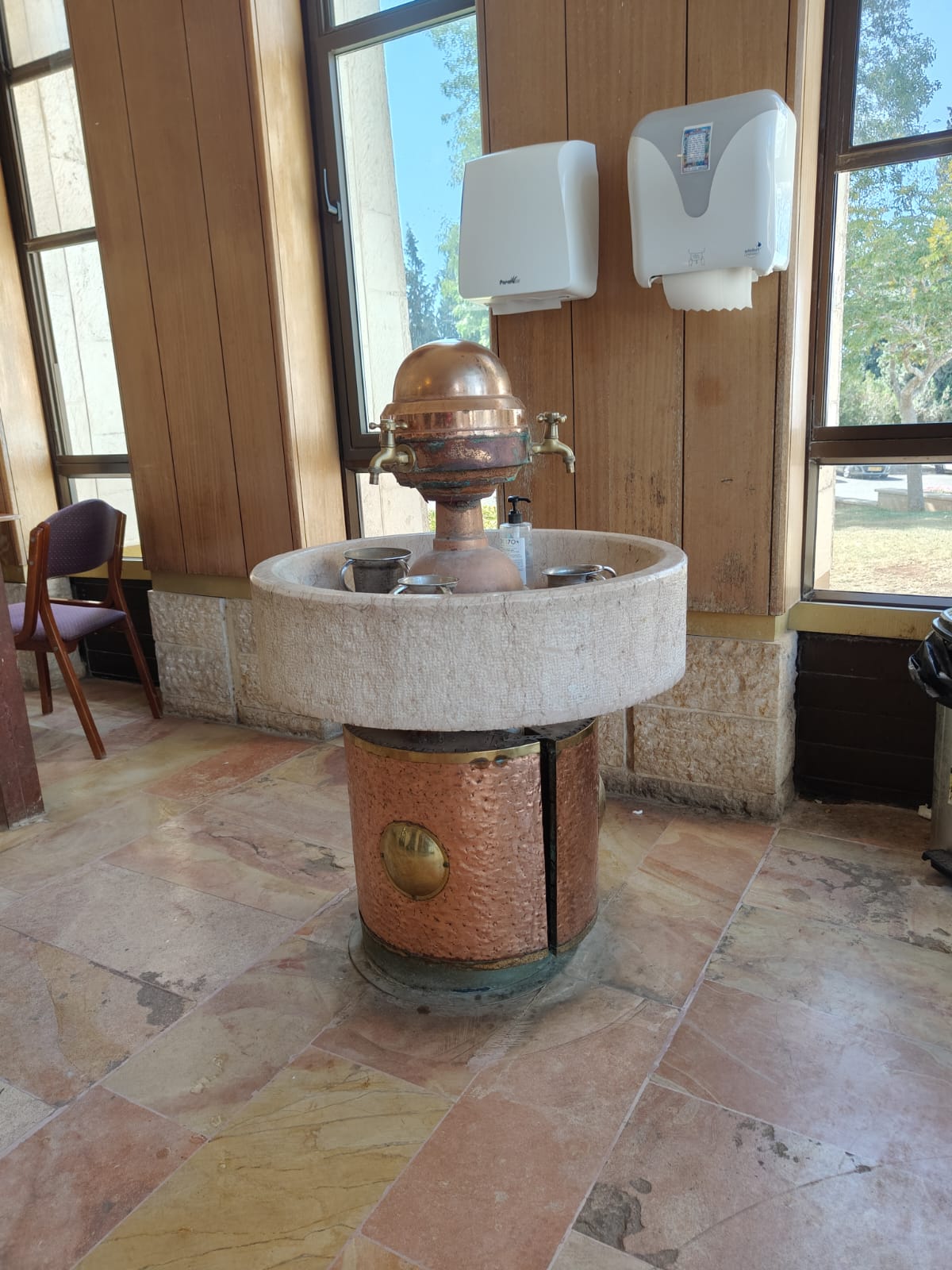When the mishna gave the amount of a whole the size of a coin did it mean up until the size of the coin is permitted but the exact size would be a treifa? Regarding some of the items listed as kosher in the mishna, the rabbis limit the cases somewhat. Do Rabbi Meir and the Rabbi really disagree about gluda – an animal that is missing its skin, as stated in the mishna?
This month’s learning is sponsored by Beth Balkany in honor of their granddaughter, Devorah Chana Serach Eichel. “May she grow up to be a lifelong learner.”
Want to dedicate learning? Get started here:


This month’s learning is sponsored by Beth Balkany in honor of their granddaughter, Devorah Chana Serach Eichel. “May she grow up to be a lifelong learner.”
Delve Deeper
Broaden your understanding of the topics on this daf with classes and podcasts from top women Talmud scholars.
New to Talmud?
Check out our resources designed to help you navigate a page of Talmud – and study at the pace, level and style that fits you.
The Hadran Women’s Tapestry
Meet the diverse women learning Gemara at Hadran and hear their stories.
Chullin 55
שיעורן בכדי סיכת קטן ועד לוג מאי לאו לוג כלמטה לא לוג כלמעלה
their measure in order to be susceptible to ritual impurity is that they can hold enough oil with which to anoint a small child. If they cannot hold this amount, they are considered useless and are not susceptible to impurity. And this measure applies only to vessels that held up to a log when they were whole; if they had originally held more, they must hold more when broken in order to be susceptible to impurity. What, is it not teaching that if it originally held exactly one log it is treated as though it had held below that amount? If so, the term: Up to, means up to and including. The Gemara responds: No, if it held exactly one log it is treated as though it held above that amount, and if broken it must be capable of holding a greater measure in order to be susceptible to impurity.
ת”ש מלוג עד סאה ברביעית מאי לאו סאה כלמטה לא סאה כלמעלה
The Gemara suggests: Come and hear proof from the continuation of the same mishna: If the vessel originally held from a log up to a se’a, its broken-off base or sides must hold a quarter-log in order to be susceptible to impurity. What, is it not teaching that if it originally held exactly a se’a it is treated as though it had held below that amount? The Gemara responds: No, if it held exactly a se’a it is treated as though it had held above that amount, and its base or sides must hold a greater measure in order to be susceptible to impurity.
ת”ש מסאה ועד סאתים בחצי לוג מאי לאו סאתים כלמטה לא סאתים כלמעלה
The Gemara suggests: Come and hear proof from the continuation of the same mishna: If the vessel had originally held from a se’aup to two se’a, its broken-off base or sides must hold half a log to be susceptible to impurity. What, is it not teaching that if it had originally held exactly two se’a it is treated as if though it had held below that amount? The Gemara responds: No, if it had held exactly two se’a it is treated as though it had held above that amount.
והתניא לוג כלמטה סאה כלמטה סאתים כלמטה
The Gemara asks: How can one explain the mishna in this manner? But isn’t it taught explicitly in a baraita: If the vessel had originally held exactly a log it is treated as though it had held below that amount; if it had held exactly a se’a it is treated as though it had held below that amount; if it had held exactly two se’a it is treated as though it had held below that amount? Evidently, the term: Up to, means up to and including the given measure, in contradiction to Rav Naḥman’s opinion that it means up to and not including the measure.
התם לחומרא דא”ר אבהו א”ר יוחנן כל שיעורי חכמים להחמיר חוץ מכגריס של כתמים להקל
The Gemara responds: The term: Up to, is always interpreted in the more stringent manner. Accordingly, there, with regard to the impurity of vessels, the term: Up to, is interpreted as up to and including in order to rule stringently, since the vessel is then more easily susceptible to impurity. As Rabbi Abbahu says that Rabbi Yoḥanan says: All measures of the Sages must be interpreted stringently, except for the measure of a groat as a standard for stains of blood found on a woman’s clothing, which is interpreted leniently. Even if the stain is exactly the size of a groat, the woman remains pure. Here, it is more stringent to interpret the phrase: Up to, as up to and including, because an animal is then more susceptible to being rendered a tereifa.
דיקא נמי דקתני עלה דההיא חמשה כלמעלה עשרה כלמטה:
The Gemara notes: The language is also precise, i.e., it is evident that the phrase: Up to, is always interpreted stringently, as the mishna (Kelim 19:2) states that if a rope extending from a rope bed is of any length up to five handbreadths, it is not susceptible to ritual impurity, but if it is of any length from five up to ten handbreadths, it is susceptible. And a baraita teaches with regard to that mishna: If the rope was exactly five handbreadths long, it is treated as though its length were above that; if the rope was exactly ten handbreadths long, it is treated as though its length were below that. In both cases, the measure is interpreted stringently.
ניטל הטחול: אמר רב עוירא משמיה דרבא לא שנו אלא ניטל אבל ניקב טרפה
§ The mishna states: If the spleen was removed the animal remains kosher. Rav Avira says in the name of Rava: The Sages taught that it is kosher only when the spleen was removed, but if it was perforated, it is a tereifa.
מתיב רבי יוסי בר אבין ואיתימא ר’ יוסי בר זבידא חותך מעובר שבמעיה מותר באכילה מן הטחול ומן הכליות אסור באכילה הא בהמה גופא שריא
Rabbi Yosei bar Avin, and some say Rabbi Yosei bar Zevida, raises an objection from a mishna in the next chapter (68a): If, prior to slaughtering an animal, one severs pieces from a fetus that is in the womb and leaves those pieces in the womb, their consumption is permitted by virtue of the slaughter of the mother animal (see 69a). By contrast, if one severs pieces of the spleen or of the kidneys of an animal and then slaughters it, then even if those pieces are left inside the animal their consumption is prohibited, because an organ severed from a living being is not permitted by the subsequent slaughter of the animal. One can infer from the mishna that the animal itself is permitted even when part of the spleen was severed. Evidently, such an animal is not a tereifa.
הוא הדין דאפילו בהמה נמי אסירא איידי דתנא רישא מותר באכילה תנא נמי סיפא אסור באכילה ואיבעית אימא ניקב לחוד ונחתך לחוד:
The Gemara responds: The same is true of the animal, and even the animal is prohibited. But since the mishna taught in the first clause, with regard to the parts of the fetus: Their consumption is permitted, it taught in the last clause with regard to the parts of the spleen: Their consumption is prohibited, to contrast between them. Or, if you wish, say instead that a perforated spleen is a discrete case, in which the animal is a tereifa, and a cut spleen is a discrete case, in which the animal is not.
ניטלו הכליות: אמר רכיש בר פפא משמיה דרב לקתה בכוליא אחת טרפה אמרי במערבא והוא דמטאי לקותא
§ The mishna states: If the kidneys were removed the animal remains kosher. Rakhish bar Pappa said in the name of Rav: If an animal was diseased in even one kidney, the animal is a tereifa. In the West, Eretz Yisrael, they say: And this applies only in a case where the disease reached
למקום חריץ והיכא מקום חריץ לחיורא דתותי מתני א”ר נחוניא שאילתינהו לכולהו טרופאי דמערבא ואמרו לי הלכתא כרכיש בר פפא ולית הלכתא כרב עוירא
the location of the crevice. And where is the location of the crevice? This is a reference to the white matter under the loins. Rav Neḥunya said: I asked all the authorities on tereifot of the West, and they said to me: The halakha is in accordance with the opinion of Rakhish bar Pappa in the name of Rav that a diseased kidney renders an animal a tereifa, but the halakha is not in accordance with the opinion of Rav Avira that a perforated spleen renders the animal a tereifa.
(דרב עוירא נמי) לא אמרן אלא בקולשיה אבל בסומכיה טרפה ואי אישתייר ביה כעובי דינר זהב כשרה
The Gemara adds: And even with regard to the opinion of Rav Avira, we said that the halakha is not in accordance with his opinion only if the spleen was perforated in its narrow, lower end, but if it was perforated in its thick, upper end, the animal is a tereifa. And even if it was perforated in its thick end, if it was not perforated completely and a layer of the spleen as thick as a gold dinar remains intact, the animal is kosher.
אמרי במערבא כל הפוסל בריאה כשר בכוליא שהרי נקב פסול בריאה וכשר בכוליא וכל שכן היכא דכשר בריאה כשר בכוליא
§ They say in the West, Eretz Yisrael: Any injury that renders an animal unfit for consumption when occurring in the lung is kosher when occurring in the kidney. For example, a perforation renders an animal unfit when occurring in the lung (see 42a), but the animal is kosher if it occurs in the kidney. And it follows that all the more so, where an animal is kosher despite an injury in the lung, it will remain kosher despite a similar injury in the kidney.
מתקיף לה ר’ תנחומא וכללא הוא והרי מוגלא דכשר בריאה ופסול בכוליא והרי מים זכין דכשרים הכא והכא אלא אמר רב אשי טרפות קא מדמית להדדי אין אומרים בטרפות זו דומה לזו שהרי חותכה מכאן ומתה חותכה מכאן וחיתה
Rabbi Tanḥuma objects to this: And is this an established principle? But what about a case of pus, where the animal is kosher if it occurs in the lung and unfit for consumption if it occurs in the kidney? And what about clear fluid, which is kosher both here and there, i.e., whether occurring in the lungs or the kidney? Rather, Rav Ashi said: Are you comparing tereifot to one another? One cannot say with regard to tereifot: This is similar to that, as one cuts an animal from here, in one place, and it dies, while one cuts it from there, in another place, and it lives. Certain injuries may compromise the kidney but not the lung, or vice versa.
ומים זכין כשרים לא אמרן אלא דצילי אבל עכירי טרפה וכי צילי נמי לא אמרן אלא דלא סריח אבל סריח טרפה
The Gemara notes: And with regard to clear fluid found in the lungs or kidney, which is kosher, we said so only in a case where the fluid was unclouded, but if it was clouded, the animal is a tereifa. And even when the fluid was unclouded, we said the animal is kosher only if the fluid is not fetid, but if it is fetid, the animal is a tereifa.
הכוליא שהקטינה בדקה עד כפול בגסה עד כענבה בינונית:
The Gemara continues to discuss cases of tereifot due to the kidneys: With regard to a kidney that shrank, in small animals, such as sheep, the animal is a tereifa if it shrank until the size of a bean; in large animals, such as cattle, the animal is a tereifa if it shrank until the size of an intermediate-sized grape.
(ניטל לחי התחתון: א”ר זירא לא שנו אלא שיכולה לחיות על ידי לעיטה והמראה טרפה):
§ The mishna states: If the animal’s lower jaw was removed, it remains kosher. With regard to this, Rabbi Zeira says: The Sages taught this only when the animal is able to live by placing food in its mouth or stuffing it down its throat. But if it cannot live by placing or stuffing food into it, it is a tereifa.
ניטלה האם שלה: תנא היא האם היא טרפחת והיא שלפוחית:
§ The mishna states: If its womb [em] was removed, the animal remains kosher. A Sage taught: The em is synonymous with the tarpaḥat, and it is synonymous with the shalpuḥit.
וחרותה בידי שמים כשרה: תנו רבנן איזוהי חרותה כל שצמקה ריאה שלה בידי שמים כשרה בידי אדם טרפה רבי שמעון בן אלעזר אומר אף בידי כל הבריות
§ The mishna states: Or if its lung shriveled [ḥaruta] by the hand of Heaven, the animal is kosher. The Sages taught in a baraita: Which is a ḥaruta? It is any animal whose lung shriveled. If this occurred by the hand of Heaven, e.g., if the lung shriveled from fright of thunder and lightning, the animal is kosher. But if it happened by the hands of a person who frightened it, e.g., if it witnessed another animal being slaughtered, it is a tereifa. Rabbi Shimon ben Elazar says: Even if the lung shriveled by the hands of any creature, e.g., if it was frightened by a lion’s roar.
איבעיא להו רבי שמעון בן אלעזר ארישא קאי ולקולא או אסיפא קאי ולחומרא
A dilemma was raised before the Sages: Is the statement of Rabbi Shimon ben Elazar referring to the first clause of the baraita, in which case the statement is a leniency, and even the roar of a lion is considered by the hand of Heaven? Or perhaps it is referring to the latter clause, and the statement is a stringency, and a lung shriveled by the hand of any creature renders the animal a tereifa?
תא שמע דתניא חרותה בידי אדם טרפה רבי שמעון בן אלעזר אומר אף בידי כל הבריות
The Gemara suggests: Come and hear a proof, as it is taught in the above baraita: A lung that was shriveled by the hands of a person renders the animal a tereifa. Rabbi Shimon ben Elazar says: Even by the hands of any creature. Evidently, Rabbi Shimon ben Elazar is referring to the latter clause.
רבה בר בר חנה הוה קאזיל במדברא אשכח הנהו דיכרי דצמיק ריאה דידהו אתא שאיל בי מדרשא אמרו ליה בקייטא אייתי משיכלי חיורי ומלינהו מיא קרירי ואנחינהו מעת לעת אי הדרן בריין בידי שמים היא וכשרה ואי לא טרפה בסיתוא אייתי משיכלי שיחומי ומלינהו מיא פשורי ואנחינהו מעת לעת אי הדרא בריא כשרה ואי לא טרפה:
The Gemara recounts: Rabba bar bar Ḥana was walking in the desert, and he found certain rams whose lungs were shriveled. He came and asked in the study hall how one can determine the cause of the shriveling. The Sages said to him: In the summer, bring white vessels and fill them with cold water and set the lungs in them for a twenty-four-hour period. If they go back to appearing healthy, i.e., if they expand, one knows that it was by the hand of Heaven and the animals are kosher; but if they do not expand, the animals are tereifa. In the winter, bring dark vessels and fill them with tepid water, and set the lungs in them for a twenty-four-hour period. If they go back to appearing healthy, they are kosher; but if not, they are tereifa.
הגלודה: תנו רבנן הגלודה רבי מאיר מכשיר וחכמים פוסלים וכבר העיד אלעזר ספרא ויוחנן בן גודגדא על הגלודה שפסולה אמר רבי שמעון בן אלעזר חזר בו רבי מאיר
§ The mishna states: In the case of an animal whose hide was removed, Rabbi Meir deems it kosher, and the Rabbis deem it a tereifa. With regard to this, the Sages taught: In the case of an animal whose hide was removed, Rabbi Meir deems it kosher, and the Rabbis deem it a tereifa and unfit for consumption. And Elazar the scribe and Yoḥanan ben Gudgeda already testified before the Sages with regard to an animal whose hide was removed that it is unfit for consumption. Rabbi Shimon ben Elazar said: Rabbi Meir retracted his statement.
מכלל דלרבי שמעון בן אלעזר פליג רבי מאיר בגלודה והתניא אמר רבי שמעון בן אלעזר לא נחלקו ר”מ וחכמים על הגלודה שפסולה וכבר העיד רבי אושעיא בנו של רבי יהודה הבשם לפני רבי עקיבא משום רבי טרפון על הגלודה שפסולה ואם נשתייר בו כסלע כשרה אמר רב נחמן בר יצחק מאי לא נחלקו לא עמד רבי מאיר במחלוקתו:
The Gemara objects: By inference, one may conclude that according to Rabbi Shimon ben Elazar, Rabbi Meir initially disagreed with regard to an animal whose hide was removed. But isn’t it taught in a baraita: Rabbi Shimon ben Elazar said: Rabbi Meir and the Sages did not disagree with regard to an animal whose hide was removed, and all agree that it is unfit for consumption. And Rabbi Oshaya, son of Rabbi Yehuda the spice merchant, already testified before Rabbi Akiva in the name of Rabbi Tarfon with regard to an animal whose hide was removed that it is unfit for consumption. And if a piece of hide the same size as a sela remained intact, the animal is kosher. The Gemara explains the objection: The phrase: Did not disagree, indicates that Rabbi Meir never disagreed with the Sages. Rav Naḥman bar Yitzḥak said: What is the meaning of the phrase: Did not disagree? It means that Rabbi Meir did not stand firm in his disagreement and retracted.
אמר מר אם נשתייר בו כסלע כשרה היכא אמר רב יהודה אמר שמואל על פני השדרה כולה
The Gemara analyzes the baraita: The Master said: If a piece of hide the same size as a sela remained intact in the animal, it is kosher. The Gemara asks: Where must this piece of hide be? Rav Yehuda said that Shmuel said: The piece of hide must be along the entire spine.
איבעיא להו דאריך וקטין דכי מצרף לה הוי כסלע או דלמא ברוחב סלע על פני השדרה כולה תא שמע דפריש רבי נהוראי משמיה דשמואל ברוחב כסלע על פני כל השדרה כולה
A dilemma was raised before the Sages: Does Shmuel mean that it is kosher if a long and thin strip of hide remains along the spine, such that when one combines its area, it will constitute the same size as a sela? Or perhaps it is kosher only if the remaining hide is the width of a sela along the entire spine? The Gemara responds: Come and hear proof from that which Rabbi Nehorai explained in the name of Shmuel: It must be the width of a sela along the entire spine.
רבה בר בר חנה אמר ראשי פרקים רבי אלעזר בן אנטיגנוס משום רבי אלעזר ברבי ינאי אמר מקום טיבורו
Rabba bar bar Ḥana says: There must be a piece of hide the size of a sela on the tips of all segments of the spine and on the tips of the femur and tibia. Rabbi Elazar ben Antigonus says in the name of Rabbi Elazar, son of Rabbi Yannai: The piece of hide must be the width of a sela at the place of its navel.
בעי רבי ינאי בר’ ישמעאל ניטל מקום השדרה וכולו קיים ניטל מקום טיבורו וכולו קיים ניטלו ראשי פרקים וכולו קיים מאי תיקו
Rabbi Yannai, son of Rabbi Yishmael, raises a dilemma: If all the hide covering the place of the spine was removed, but all of the remaining hide was intact, or if the hide covering the place of its navel was removed but all of the remaining hide was intact, or if the hide covering all the tips of the segments were removed but all of the remaining hide was intact, what is the halakha? The Gemara responds: The dilemma shall stand unresolved.
אמר רב כל העור כולו מציל בגלודה חוץ מעור בית הפרסות ורבי יוחנן אמר אפילו עור בית הפרסות נמי מציל
Rav says: Any portion of the hide that is the size of a sela saves an animal whose hide was removed from becoming a tereifa, except for the hide of the hooves, which is not considered hide. And Rabbi Yoḥanan says: Even the hide of the hooves saves it.
בעא מיניה רבי אסי מרבי יוחנן עור בית הפרסות מהו שיציל בגלודה אמר ליה מציל אמר ליה למדתנו רבינו אלו שעורותיהן כבשרן עור בית הפרסות אמר ליה אל תקניטני שבלשון יחיד אני שונה אותה
The Gemara recounts: Rabbi Asi asked Rabbi Yoḥanan: With regard to the hide of the hooves, what is the halakha? Does it save an animal whose hide was removed if a piece of it the size of a sela remains? Rabbi Yoḥanan said to him: It saves the animal. Rabbi Asi said to him: But didn’t you teach us, our teacher, the following mishna (122a): These are the entities whose hide is like their flesh in terms of halakhic status, in that it transmits ritual impurity…the skin of a head of a young calf, and the hide of the hooves? Evidently, the hide of the hooves is considered like flesh and not true skin. Rabbi Yoḥanan said to him: Do not trouble me by invoking that mishna, as I teach it in the singular. Only according to one Sage, Rabbi Shimon, is the hide of the hooves not true skin; according to the Rabbis, it is considered true skin.
דתניא השוחט את העולה להקטיר כזית מעור של תחת האליה חוץ למקומו פסול ואין בו כרת חוץ לזמנו פגול וחייבין עליו כרת
As it is taught in a baraita: One who slaughters a burnt offering with intent to burn an olive-bulk of the hide beneath the tail outside its designated area, i.e., outside the Temple courtyard, renders the offering unfit, but there is no liability for excision from the World-to-Come [karet] for one who partakes of the offering. If he had intent to burn it beyond its designated time, then it is rendered piggul, and one is liable to receive karet for partaking of it. This halakha usually applies to an offering’s flesh but not its hide. Since the hide beneath the tail is soft, it is treated like part of the flesh. This is the opinion of the Rabbis.
אליעזר בן יהודה איש איבלים אמר משום רבי יעקב וכן היה רבי שמעון בן יהודה (איש) עיכוס אומר משום רבי שמעון אחד עור בית הפרסות ואחד עור הראש של עגל הרך ואחד עור של תחת האליה וכל שמנו חכמים גבי טומאה אלו שעורותיהן כבשרן
Eliezer ben Yehuda of Evlayim said in the name of Rabbi Ya’akov, and so says Rabbi Shimon ben Yehuda of Ikos in the name of Rabbi Shimon: Whether the hide of the hooves, or the hide of the head of a young calf, or the hide beneath the tail, or any hide that the Sages listed with regard to ritual impurity under the heading: These are the entities whose hide is like their flesh in terms of halakhic status,





